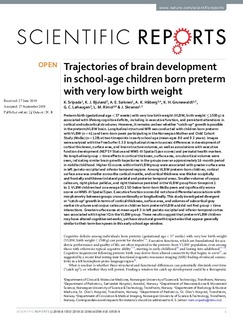| dc.contributor.author | Sripada, Kam | |
| dc.contributor.author | Bjuland, Knut Jørgen | |
| dc.contributor.author | Sølsnes, Anne Elisabeth | |
| dc.contributor.author | Håberg, Asta | |
| dc.contributor.author | Grunewaldt, Kristine Hermansen | |
| dc.contributor.author | Løhaugen, Gro | |
| dc.contributor.author | Rimol, Lars Morten | |
| dc.contributor.author | Skranes, Jon Sverre | |
| dc.date.accessioned | 2019-01-30T10:04:13Z | |
| dc.date.available | 2019-01-30T10:04:13Z | |
| dc.date.created | 2018-10-22T15:30:05Z | |
| dc.date.issued | 2018 | |
| dc.identifier.issn | 2045-2322 | |
| dc.identifier.uri | http://hdl.handle.net/11250/2583028 | |
| dc.description.abstract | Preterm birth (gestational age < 37 weeks) with very low birth weight (VLBW, birth weight ≤ 1500 g) is associated with lifelong cognitive deficits, including in executive function, and persistent alterations in cortical and subcortical structures. However, it remains unclear whether “catch-up” growth is possible in the preterm/VLBW brain. Longitudinal structural MRI was conducted with children born preterm with VLBW (n = 41) and term-born peers participating in the Norwegian Mother and Child Cohort Study (MoBa) (n = 128) at two timepoints in early school age (mean ages 8.0 and 9.3 years). Images were analyzed with the FreeSurfer 5.3.0 longitudinal stream to assess differences in development of cortical thickness, surface area, and brain structure volumes, as well as associations with executive function development (NEPSY Statue and WMS-III Spatial Span scores) and perinatal health markers. No longitudinal group × time effects in cortical thickness, surface area, or subcortical volumes were seen, indicating similar brain growth trajectories in the groups over an approximately 16-month period in middle childhood. Higher IQ scores within the VLBW group were associated with greater surface area in left parieto-occipital and inferior temporal regions. Among VLBW preterm-born children, cortical surface area was smaller across the cortical mantle, and cortical thickness was thicker occipitally and frontally and thinner in lateral parietal and posterior temporal areas. Smaller volumes of corpus callosum, right globus pallidus, and right thalamus persisted in the VLBW group from timepoint 1 to 2. VLBW children had on average IQ 1 SD below term-born MoBa peers and significantly worse scores on WMS-III Spatial Span. Executive function scores did not show differential associations with morphometry between groups cross-sectionally or longitudinally. This study investigated divergent or “catch-up” growth in terms of cortical thickness, surface area, and volumes of subcortical gray matter structures and corpus callosum in children born preterm/VLBW and did not find group × time interactions. Greater surface area at mean age 9.3 in left parieto-occipital and inferior temporal cortex was associated with higher IQ in the VLBW group. These results suggest that preterm VLBW children may have altered cognitive networks, yet have structural growth trajectories that appear generally similar to their term-born peers in this early school age window. | nb_NO |
| dc.language.iso | eng | nb_NO |
| dc.publisher | Nature Research | nb_NO |
| dc.relation.uri | https://www.nature.com/articles/s41598-018-33530-8 | |
| dc.rights | Navngivelse 4.0 Internasjonal | * |
| dc.rights.uri | http://creativecommons.org/licenses/by/4.0/deed.no | * |
| dc.title | Trajectories of brain development in school-age children born preterm with very low birth weight | nb_NO |
| dc.title.alternative | Trajectories of brain development in school-age children born preterm with very low birth weight | nb_NO |
| dc.type | Journal article | nb_NO |
| dc.type | Peer reviewed | nb_NO |
| dc.description.version | publishedVersion | nb_NO |
| dc.source.volume | 8 | nb_NO |
| dc.source.journal | Scientific Reports | nb_NO |
| dc.identifier.doi | https://doi.org/10.1038/s41598-018-33530-8 | |
| dc.identifier.cristin | 1622372 | |
| dc.description.localcode | © The Author(s) 2018. This article is distributed under the terms of the Creative Commons Attribution 4.0 International License (http://creativecommons.org/licenses/by/4.0/) | nb_NO |
| cristin.unitcode | 194,65,15,0 | |
| cristin.unitcode | 194,65,30,0 | |
| cristin.unitcode | 194,65,25,0 | |
| cristin.unitname | Institutt for klinisk og molekylær medisin | |
| cristin.unitname | Institutt for nevromedisin og bevegelsesvitenskap | |
| cristin.unitname | Institutt for sirkulasjon og bildediagnostikk | |
| cristin.ispublished | true | |
| cristin.fulltext | original | |
| cristin.qualitycode | 1 | |

